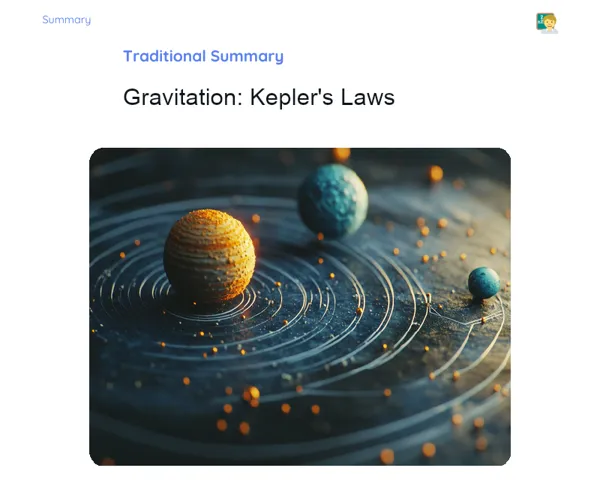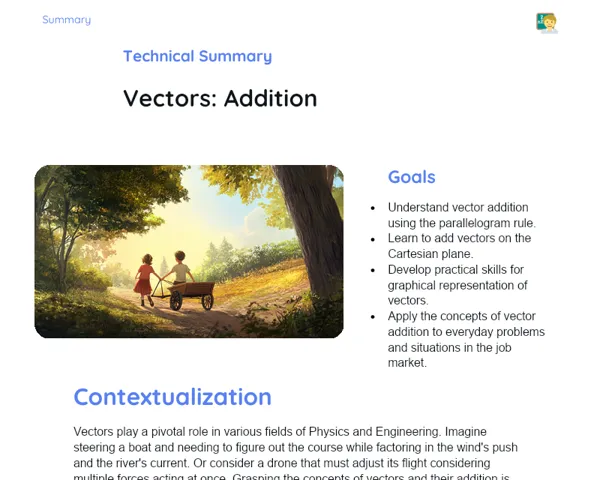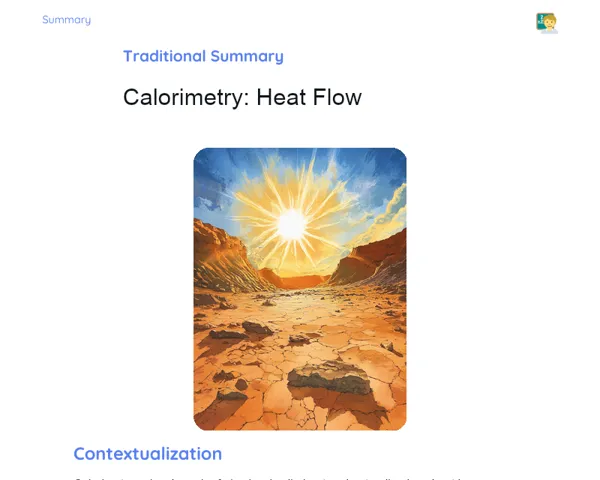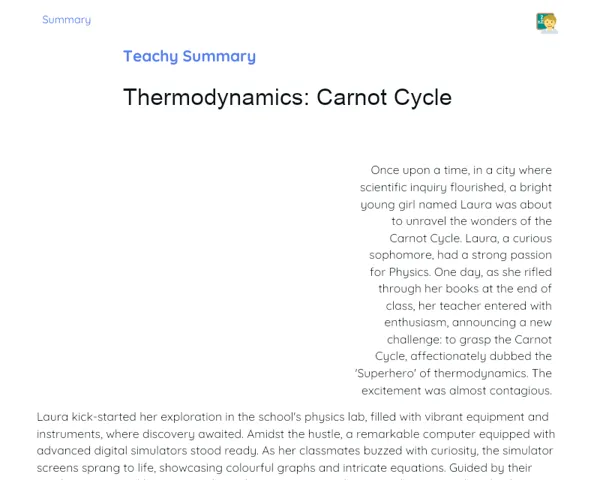Socioemotional Summary Conclusion
Goals
1. Grasp that pressure is the force exerted on a surface, divided by that surface's area.
2. Calculate the pressure of a gas contained within a vessel.
Contextualization
Picture yourself holding a party balloon 🎈. Have you ever considered how the pressure inside keeps it inflated and gives it that delightful shape? Let’s dive into how this pressure operates and relates to thermodynamics, which influence everything from the performance of car tires to the soaring of hot air balloons. Let’s unravel these fascinating concepts together!
Exercising Your Knowledge
Pressure
Pressure is defined as the force applied perpendicularly to a surface, divided by the area of that surface. Simply put, think of pushing a door with your palm. The force you exert on the door, divided by the area of your hand, reflects the pressure you generate. In physics, we represent this with the formula P = F/A, where P stands for pressure, F for force, and A for area.
-
Pressure is force per unit area: This explains why a nail can penetrate wood so easily – its sharp tip focuses the force on a small area, generating high pressure.
-
Pressure Unit: In the International System of Units (SI), pressure is measured in Pascals (Pa), corresponding to one Newton per square meter (N/m²).
-
Practical Application: Grasping pressure is key in various everyday scenarios, such as in construction, the operation of vehicle tires, and in the healthcare sector, like while utilizing sphygmomanometers for blood pressure measurement.
Force
Force refers to an interaction that causes a change in an object's motion when it's unbalanced. Measured in Newtons (N) in the International System of Units (SI), force is a vital element in the formula for pressure. Without force, pressure wouldn’t exist, and many natural and man-made phenomena wouldn’t occur.
-
Force is an interaction: This could be a push, like moving a chair, or a pull, like tugging a rope.
-
Effect of Force: When applied, force can alter an object's speed, direction, or shape, similar to crushing a can.
-
Unit of Measurement: Force is measured in Newtons, named after Isaac Newton, who established the foundational laws of motion that underpin classical physics.
Ideal Gas
An ideal gas is a theoretical framework that simplifies the behavior of gases in physics. It assumes that the molecules of an ideal gas do not interact and take up minimal space. This model aids in predicting gas behavior under varying conditions of pressure, volume, and temperature.
-
Theoretical Model: The concept of an ideal gas is a simplification since all gas molecules actually exert forces on one another.
-
Ideal Gas Law: The equation PV = nRT elucidates the relationship between pressure (P), volume (V), quantity of substance (n), ideal gas constant (R), and temperature (T).
-
Practical Applications: Despite being a simplified model, the idea of an ideal gas is invaluable for anticipating gas behavior in various practical situations, including chemical engineering and atmospheric research.
Key Terms
-
Pressure: The force exerted on a surface, divided by that surface's area.
-
Force: An interaction that, when unbalanced, induces a change in motion of an object.
-
Ideal Gas: Theoretical gas model presuming that molecules do not engage with one another and occupy negligible space.
-
Pascal (Pa): The unit of pressure measurement in the International System of Units (SI).
-
Ideal Gas Law: PV = nRT
For Reflection
-
How does understanding pressure enhance your problem-solving abilities in different aspects of life?
-
In what way can emotional awareness impact your collaborative work during science experiments?
-
How can deep breathing techniques help you manage stress in difficult situations, both in academics and beyond?
Important Conclusions
-
The pressure of a gas is defined as the force applied to a surface, divided by the area of that surface.
-
The pressure formula is expressed as P = F/A, where P represents pressure, F indicates force, and A denotes area.
-
Grasping the concept of ideal gases and the formula PV = nRT is crucial for predicting how gases behave under different conditions.
-
Regular practice of deep breathing can significantly enhance concentration and alleviate anxiety while studying.
Impacts on Society
In your everyday life, gas pressure is integral to many elements, from ensuring the safety of your vehicle’s tires to optimizing the efficiency of heating and cooling systems. Imagine if the pressure in your car's tires were incorrect: this could lead to mishaps due to loss of control. Moreover, our air conditioning systems, which provide relief during the heat of summer, depend on a solid understanding of thermodynamic principles for their optimal function.
On an emotional note, comprehending gas pressure may assist you in dealing with high-pressure moments in life. Just as a balloon requires the right pressure to avoid popping, knowing how to handle 'emotional pressure' allows you to maintain calm during stressful scenarios, such as significant exams or challenging times. Techniques for emotional regulation, like the Deep Breathing methods we practice, are essential for sustaining your well-being and focus.
Dealing with Emotions
To help you manage your emotions while studying, consider using the RULER method. First, Recognize your emotions: if you feel overwhelmed or anxious while examining pressure concepts or equations, acknowledge those feelings. Understand the root of these emotions – is it the complexity of the material or exhaustion? Label your emotions accurately, identifying them as anxiety or frustration. Next, Express them in a healthy way: discuss your feelings with a classmate, write in a journal, or take a short break. Finally, Regulate your emotions by employing techniques such as deep breathing, meditation, or brief stretching. This practice will help you stay composed and focused, promoting effective learning.
Study Tips
-
Establish a calm and organized study space where you can focus without distractions. Soft instrumental music or nature sounds may enhance your concentration.
-
Create visual summaries, such as mind maps or diagrams, to clarify the relationships between pressure, volume, and temperature of gases. This approach can make studying more engaging and enjoyable!
-
Practice articulating the concepts you've learned to someone else, such as a friend or family member. Teaching others is one of the best ways to reinforce your own understanding.



